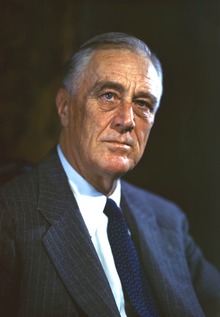President Franklin Roosevelt
| Franklin D. Roosevelt | |
|---|---|
 |
|
| 32nd President of the United States | |
|
In office March 4, 1933 – April 12, 1945 |
|
| Vice President |
John Nance Garner (1933–1941) Henry A. Wallace (1941–1945) Harry S. Truman (1945) |
| Preceded by | Herbert Hoover |
| Succeeded by | Harry S. Truman |
| 44th Governor of New York | |
|
In office January 1, 1929 – December 31, 1932 |
|
| Lieutenant | Herbert H. Lehman |
| Preceded by | Al Smith |
| Succeeded by | Herbert H. Lehman |
| Assistant Secretary of the Navy | |
|
In office March 17, 1913 – August 26, 1920 |
|
| President | Woodrow Wilson |
| Preceded by | Beekman Winthrop |
| Succeeded by | Gordon Woodbury |
| Member of the New York State Senate for the 26th District |
|
|
In office January 1, 1911 – March 17, 1913 |
|
| Preceded by | John F. Schlosser |
| Succeeded by | James E. Towner |
| Personal details | |
| Born |
Franklin Delano Roosevelt January 30, 1882 Hyde Park, New York, U.S. |
| Died | April 12, 1945 (aged 63) Warm Springs, Georgia, U.S. |
| Resting place | Home of FDR National Historic Site, Hyde Park, New York |
| Political party | Democratic |
| Spouse(s) | Eleanor Roosevelt (m. 1905) |
| Relations | See Roosevelt family and Delano family |
| Children | |
| Parents |
James Roosevelt I Sara Roosevelt |
| Education | |
| Signature | |
| Supreme Court Appointments by President Franklin D. Roosevelt | ||
|---|---|---|
| Position | Name | Term |
| Chief Justice | Harlan Fiske Stone | 1941–1946 |
| Associate Justice | Hugo Black | 1937–1971 |
| Stanley Forman Reed | 1938–1957 | |
| Felix Frankfurter | 1939–1962 | |
| William O. Douglas | 1939–1975 | |
| Frank Murphy | 1940–1949 | |
| James F. Byrnes | 1941–1942 | |
| Robert H. Jackson | 1941–1954 | |
| Wiley Blount Rutledge | 1943–1949 | |
Franklin Delano Roosevelt (/ˈroʊzəvəlt/, his own pronunciation, or /ˈroʊzəvɛlt/; January 30, 1882 – April 12, 1945), commonly known as FDR, was an American statesman and political leader who served as the 32nd President of the United States from 1933 until his death in 1945. A Democrat, he won a record four presidential elections and emerged as a central figure in world events during the mid-20th century. He directed the United States government during most of the Great Depression and World War II. As a dominant leader of his party, he built the New Deal Coalition, realigning American politics into the Fifth Party System and defining American liberalism throughout the middle third of the 20th century. He is often rated by scholars as one of the three greatest U.S. Presidents, along with George Washington and Abraham Lincoln.
...
Wikipedia
